ECON 11026 - RBA Policy, Economic Indicators & Case Study 2017
VerifiedAdded on 2023/06/15
|20
|4112
|59
Case Study
AI Summary
This case study delves into the Reserve Bank of Australia's (RBA) monetary policy decisions, particularly focusing on the historically low cash rate of 1.50 percent. It examines the goals of monetary policy, including price stability, money neutrality, exchange rate stability, economic growth, and full employment, and discusses the functions of money and the RBA. The study emphasizes the importance of considering the economic performance of key trade partners like Japan, China, the USA, and India when formulating monetary policy. It justifies the low cash rate in terms of stimulating investment and maintaining economic growth, while also addressing its impact on the housing market. The analysis further explores the equilibrium in the money market and the mechanism of monetary transmission. Finally, it reviews key economic performance indicators of Australia and discusses strategies for sustaining economic growth.

Running Head: PRINCIPLE OF ECONOMICS
Principle of Economics
Name of the Student
Name of the University
Author note
Principle of Economics
Name of the Student
Name of the University
Author note
Paraphrase This Document
Need a fresh take? Get an instant paraphrase of this document with our AI Paraphraser
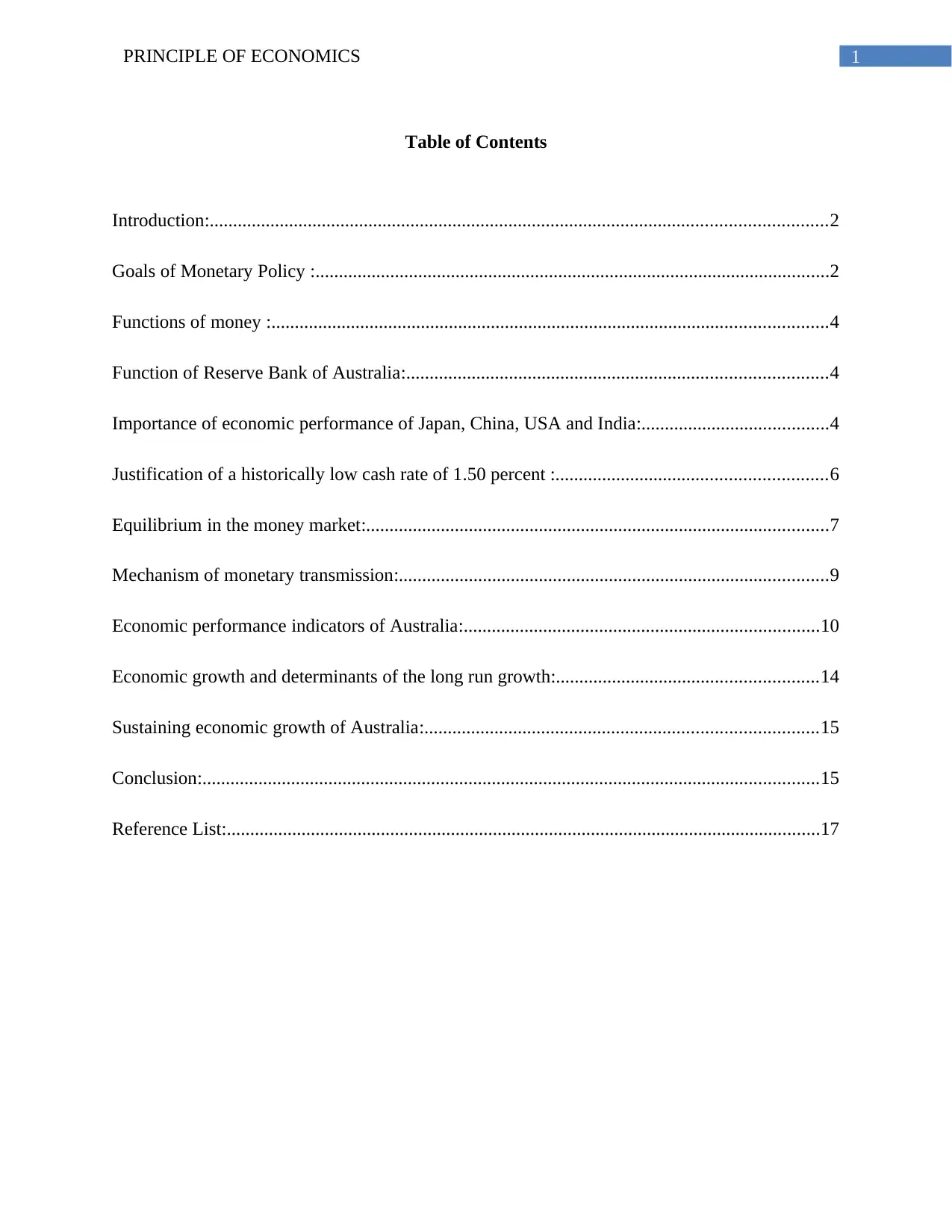
1PRINCIPLE OF ECONOMICS
Table of Contents
Introduction:....................................................................................................................................2
Goals of Monetary Policy :..............................................................................................................2
Functions of money :.......................................................................................................................4
Function of Reserve Bank of Australia:..........................................................................................4
Importance of economic performance of Japan, China, USA and India:........................................4
Justification of a historically low cash rate of 1.50 percent :..........................................................6
Equilibrium in the money market:...................................................................................................7
Mechanism of monetary transmission:............................................................................................9
Economic performance indicators of Australia:............................................................................10
Economic growth and determinants of the long run growth:........................................................14
Sustaining economic growth of Australia:....................................................................................15
Conclusion:....................................................................................................................................15
Reference List:...............................................................................................................................17
Table of Contents
Introduction:....................................................................................................................................2
Goals of Monetary Policy :..............................................................................................................2
Functions of money :.......................................................................................................................4
Function of Reserve Bank of Australia:..........................................................................................4
Importance of economic performance of Japan, China, USA and India:........................................4
Justification of a historically low cash rate of 1.50 percent :..........................................................6
Equilibrium in the money market:...................................................................................................7
Mechanism of monetary transmission:............................................................................................9
Economic performance indicators of Australia:............................................................................10
Economic growth and determinants of the long run growth:........................................................14
Sustaining economic growth of Australia:....................................................................................15
Conclusion:....................................................................................................................................15
Reference List:...............................................................................................................................17
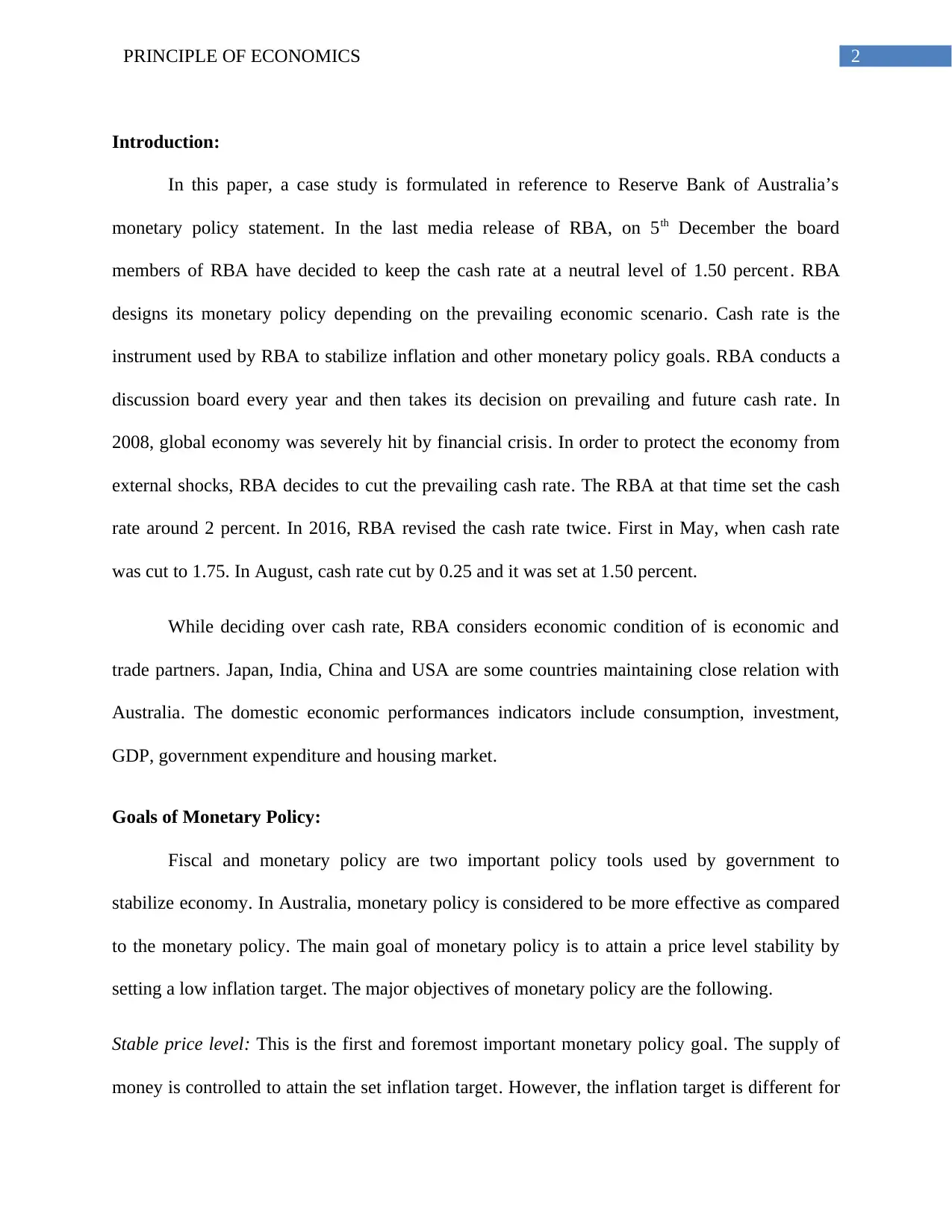
2PRINCIPLE OF ECONOMICS
Introduction:
In this paper, a case study is formulated in reference to Reserve Bank of Australia’s
monetary policy statement. In the last media release of RBA, on 5th December the board
members of RBA have decided to keep the cash rate at a neutral level of 1.50 percent. RBA
designs its monetary policy depending on the prevailing economic scenario. Cash rate is the
instrument used by RBA to stabilize inflation and other monetary policy goals. RBA conducts a
discussion board every year and then takes its decision on prevailing and future cash rate. In
2008, global economy was severely hit by financial crisis. In order to protect the economy from
external shocks, RBA decides to cut the prevailing cash rate. The RBA at that time set the cash
rate around 2 percent. In 2016, RBA revised the cash rate twice. First in May, when cash rate
was cut to 1.75. In August, cash rate cut by 0.25 and it was set at 1.50 percent.
While deciding over cash rate, RBA considers economic condition of is economic and
trade partners. Japan, India, China and USA are some countries maintaining close relation with
Australia. The domestic economic performances indicators include consumption, investment,
GDP, government expenditure and housing market.
Goals of Monetary Policy:
Fiscal and monetary policy are two important policy tools used by government to
stabilize economy. In Australia, monetary policy is considered to be more effective as compared
to the monetary policy. The main goal of monetary policy is to attain a price level stability by
setting a low inflation target. The major objectives of monetary policy are the following.
Stable price level: This is the first and foremost important monetary policy goal. The supply of
money is controlled to attain the set inflation target. However, the inflation target is different for
Introduction:
In this paper, a case study is formulated in reference to Reserve Bank of Australia’s
monetary policy statement. In the last media release of RBA, on 5th December the board
members of RBA have decided to keep the cash rate at a neutral level of 1.50 percent. RBA
designs its monetary policy depending on the prevailing economic scenario. Cash rate is the
instrument used by RBA to stabilize inflation and other monetary policy goals. RBA conducts a
discussion board every year and then takes its decision on prevailing and future cash rate. In
2008, global economy was severely hit by financial crisis. In order to protect the economy from
external shocks, RBA decides to cut the prevailing cash rate. The RBA at that time set the cash
rate around 2 percent. In 2016, RBA revised the cash rate twice. First in May, when cash rate
was cut to 1.75. In August, cash rate cut by 0.25 and it was set at 1.50 percent.
While deciding over cash rate, RBA considers economic condition of is economic and
trade partners. Japan, India, China and USA are some countries maintaining close relation with
Australia. The domestic economic performances indicators include consumption, investment,
GDP, government expenditure and housing market.
Goals of Monetary Policy:
Fiscal and monetary policy are two important policy tools used by government to
stabilize economy. In Australia, monetary policy is considered to be more effective as compared
to the monetary policy. The main goal of monetary policy is to attain a price level stability by
setting a low inflation target. The major objectives of monetary policy are the following.
Stable price level: This is the first and foremost important monetary policy goal. The supply of
money is controlled to attain the set inflation target. However, the inflation target is different for
⊘ This is a preview!⊘
Do you want full access?
Subscribe today to unlock all pages.

Trusted by 1+ million students worldwide
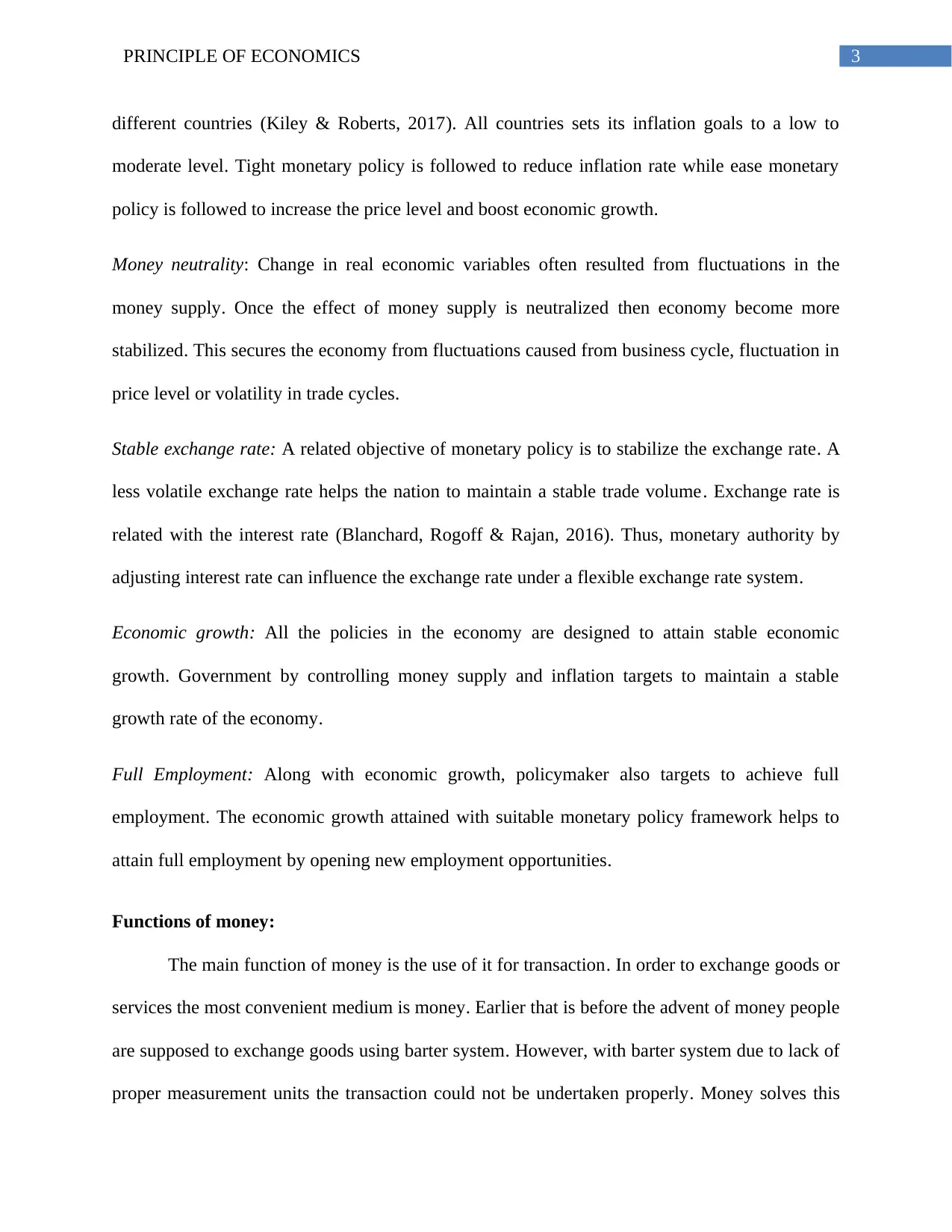
3PRINCIPLE OF ECONOMICS
different countries (Kiley & Roberts, 2017). All countries sets its inflation goals to a low to
moderate level. Tight monetary policy is followed to reduce inflation rate while ease monetary
policy is followed to increase the price level and boost economic growth.
Money neutrality: Change in real economic variables often resulted from fluctuations in the
money supply. Once the effect of money supply is neutralized then economy become more
stabilized. This secures the economy from fluctuations caused from business cycle, fluctuation in
price level or volatility in trade cycles.
Stable exchange rate: A related objective of monetary policy is to stabilize the exchange rate. A
less volatile exchange rate helps the nation to maintain a stable trade volume. Exchange rate is
related with the interest rate (Blanchard, Rogoff & Rajan, 2016). Thus, monetary authority by
adjusting interest rate can influence the exchange rate under a flexible exchange rate system.
Economic growth: All the policies in the economy are designed to attain stable economic
growth. Government by controlling money supply and inflation targets to maintain a stable
growth rate of the economy.
Full Employment: Along with economic growth, policymaker also targets to achieve full
employment. The economic growth attained with suitable monetary policy framework helps to
attain full employment by opening new employment opportunities.
Functions of money:
The main function of money is the use of it for transaction. In order to exchange goods or
services the most convenient medium is money. Earlier that is before the advent of money people
are supposed to exchange goods using barter system. However, with barter system due to lack of
proper measurement units the transaction could not be undertaken properly. Money solves this
different countries (Kiley & Roberts, 2017). All countries sets its inflation goals to a low to
moderate level. Tight monetary policy is followed to reduce inflation rate while ease monetary
policy is followed to increase the price level and boost economic growth.
Money neutrality: Change in real economic variables often resulted from fluctuations in the
money supply. Once the effect of money supply is neutralized then economy become more
stabilized. This secures the economy from fluctuations caused from business cycle, fluctuation in
price level or volatility in trade cycles.
Stable exchange rate: A related objective of monetary policy is to stabilize the exchange rate. A
less volatile exchange rate helps the nation to maintain a stable trade volume. Exchange rate is
related with the interest rate (Blanchard, Rogoff & Rajan, 2016). Thus, monetary authority by
adjusting interest rate can influence the exchange rate under a flexible exchange rate system.
Economic growth: All the policies in the economy are designed to attain stable economic
growth. Government by controlling money supply and inflation targets to maintain a stable
growth rate of the economy.
Full Employment: Along with economic growth, policymaker also targets to achieve full
employment. The economic growth attained with suitable monetary policy framework helps to
attain full employment by opening new employment opportunities.
Functions of money:
The main function of money is the use of it for transaction. In order to exchange goods or
services the most convenient medium is money. Earlier that is before the advent of money people
are supposed to exchange goods using barter system. However, with barter system due to lack of
proper measurement units the transaction could not be undertaken properly. Money solves this
Paraphrase This Document
Need a fresh take? Get an instant paraphrase of this document with our AI Paraphraser

4PRINCIPLE OF ECONOMICS
problem and provide a suitable unit for capturing worth of any produced goods or service.
Money is used as a store of value (Sardoni, 2015). It is possible to store money for a long
horizon and thus determines purchasing power in future. The value of money though fluctuates
with level of inflation but it always holds some worth. The value of any stored wealth is also
measured in terms of money.
Function of Reserve Bank of Australia:
Reserve Bank of Australia is the central monetary authority. It takes all the decision
related to money supply, interest rate and other money market decision in favor of Australia’s
prosperity. RBA aims to maintain a stable value of Australian dollar, prints currency, maintain
full employment and overall well-being (Cheung, Manning & Moore, 2014). Achieving a stable
price level is one of the primary objectives RBA. The targeted inflation rate in Australia lies
between 2-3 percent. RBA also looks after all other form of financial transaction like control of
foreign exchange reserve, control overseas financial transaction and control other functions of
banks.
Importance of economic performance of Japan, China, USA and India:
In times of taking decision regarding cash rates, RBA needs to consider economic
performance of nation whose economy is related with Australian economy. Economic expansion
of trade partners positively influences economic performance of Australia. During volatile
economic condition of partner countries, strong domestic support is needed to overcome external
shocks.
China is one nation whose economic movement affects Australia the most. There is a
bilateral trade and financial relation between China and Australia. China is one of the fastest
problem and provide a suitable unit for capturing worth of any produced goods or service.
Money is used as a store of value (Sardoni, 2015). It is possible to store money for a long
horizon and thus determines purchasing power in future. The value of money though fluctuates
with level of inflation but it always holds some worth. The value of any stored wealth is also
measured in terms of money.
Function of Reserve Bank of Australia:
Reserve Bank of Australia is the central monetary authority. It takes all the decision
related to money supply, interest rate and other money market decision in favor of Australia’s
prosperity. RBA aims to maintain a stable value of Australian dollar, prints currency, maintain
full employment and overall well-being (Cheung, Manning & Moore, 2014). Achieving a stable
price level is one of the primary objectives RBA. The targeted inflation rate in Australia lies
between 2-3 percent. RBA also looks after all other form of financial transaction like control of
foreign exchange reserve, control overseas financial transaction and control other functions of
banks.
Importance of economic performance of Japan, China, USA and India:
In times of taking decision regarding cash rates, RBA needs to consider economic
performance of nation whose economy is related with Australian economy. Economic expansion
of trade partners positively influences economic performance of Australia. During volatile
economic condition of partner countries, strong domestic support is needed to overcome external
shocks.
China is one nation whose economic movement affects Australia the most. There is a
bilateral trade and financial relation between China and Australia. China is one of the fastest

5PRINCIPLE OF ECONOMICS
growing developing nation in world. In achieving the growth rate China needs some external
support. Most of the raw material, which China demands, come from Australia. China provides
an extended domestic market for goods exported from Australia. Australia has a large stock of
mineral resources (Pascali, 2017). The mineral resources are exported to China to support the
energy sector. In terms of service, Australia assists China in its education service. China invests
in different projects of Australia. Fluctuations in such investments affects Australian economy.
USA is another nation influencing economic behavior of Australia. USA is regarded as
the most powerful and largest economy in the globe. Australia and USA singed an effective
bilateral trade agreement in 2005 to strengthen their economic relation. The two nations
exchanged goods and services worth billions of dollar each year (Mascitelli & Wilson, 2018).
USA makes capital investment in Australia. The firms in USA operate their plants in Australia.
These create both employment opportunity and economic prosperity.
Australia has established a trade relation with India. India is the fifth largest market for
Australian export. Billions of worth of goods are exchange between these two nations. Australia
exports minerals, vegetables and services to India. India with its economic growth invests in
different sectors of Australia (Xiang, Kuang & Li, 2017). The attractive sectors for investment
include manufacturing, energy and resource sector and other services.
Another important trade partner of Australia is Japan. Japan makes adequate capital
investment in Australia. The Japan Australian Economic Partnership in 2014 strengthens the
relation between Australia and Japan (Piggott & Woodland, 2016). With this agreement the all
the trade and investment barriers has been eliminated. Like other nation, Australia exports
energy and minerals to Japan.
growing developing nation in world. In achieving the growth rate China needs some external
support. Most of the raw material, which China demands, come from Australia. China provides
an extended domestic market for goods exported from Australia. Australia has a large stock of
mineral resources (Pascali, 2017). The mineral resources are exported to China to support the
energy sector. In terms of service, Australia assists China in its education service. China invests
in different projects of Australia. Fluctuations in such investments affects Australian economy.
USA is another nation influencing economic behavior of Australia. USA is regarded as
the most powerful and largest economy in the globe. Australia and USA singed an effective
bilateral trade agreement in 2005 to strengthen their economic relation. The two nations
exchanged goods and services worth billions of dollar each year (Mascitelli & Wilson, 2018).
USA makes capital investment in Australia. The firms in USA operate their plants in Australia.
These create both employment opportunity and economic prosperity.
Australia has established a trade relation with India. India is the fifth largest market for
Australian export. Billions of worth of goods are exchange between these two nations. Australia
exports minerals, vegetables and services to India. India with its economic growth invests in
different sectors of Australia (Xiang, Kuang & Li, 2017). The attractive sectors for investment
include manufacturing, energy and resource sector and other services.
Another important trade partner of Australia is Japan. Japan makes adequate capital
investment in Australia. The Japan Australian Economic Partnership in 2014 strengthens the
relation between Australia and Japan (Piggott & Woodland, 2016). With this agreement the all
the trade and investment barriers has been eliminated. Like other nation, Australia exports
energy and minerals to Japan.
⊘ This is a preview!⊘
Do you want full access?
Subscribe today to unlock all pages.

Trusted by 1+ million students worldwide
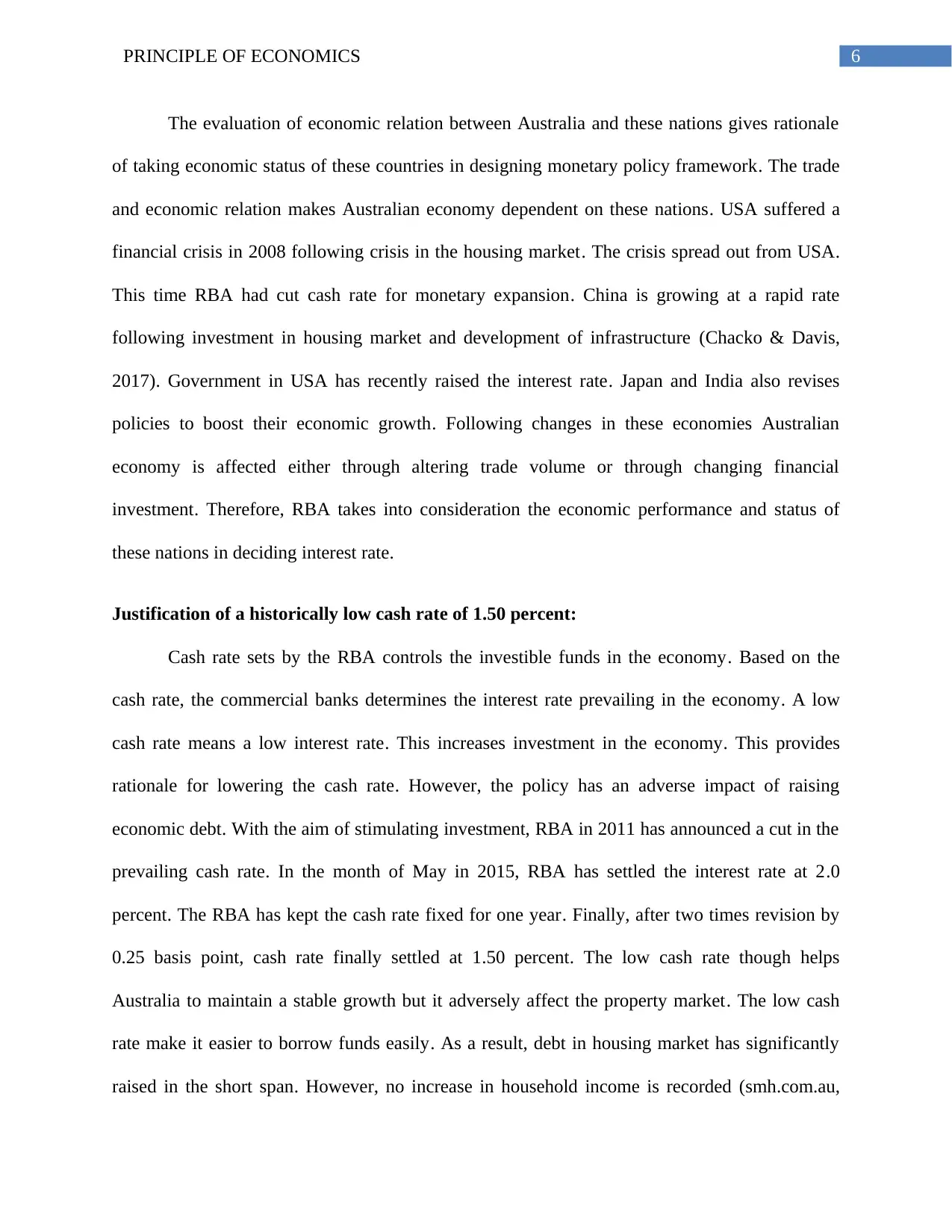
6PRINCIPLE OF ECONOMICS
The evaluation of economic relation between Australia and these nations gives rationale
of taking economic status of these countries in designing monetary policy framework. The trade
and economic relation makes Australian economy dependent on these nations. USA suffered a
financial crisis in 2008 following crisis in the housing market. The crisis spread out from USA.
This time RBA had cut cash rate for monetary expansion. China is growing at a rapid rate
following investment in housing market and development of infrastructure (Chacko & Davis,
2017). Government in USA has recently raised the interest rate. Japan and India also revises
policies to boost their economic growth. Following changes in these economies Australian
economy is affected either through altering trade volume or through changing financial
investment. Therefore, RBA takes into consideration the economic performance and status of
these nations in deciding interest rate.
Justification of a historically low cash rate of 1.50 percent:
Cash rate sets by the RBA controls the investible funds in the economy. Based on the
cash rate, the commercial banks determines the interest rate prevailing in the economy. A low
cash rate means a low interest rate. This increases investment in the economy. This provides
rationale for lowering the cash rate. However, the policy has an adverse impact of raising
economic debt. With the aim of stimulating investment, RBA in 2011 has announced a cut in the
prevailing cash rate. In the month of May in 2015, RBA has settled the interest rate at 2.0
percent. The RBA has kept the cash rate fixed for one year. Finally, after two times revision by
0.25 basis point, cash rate finally settled at 1.50 percent. The low cash rate though helps
Australia to maintain a stable growth but it adversely affect the property market. The low cash
rate make it easier to borrow funds easily. As a result, debt in housing market has significantly
raised in the short span. However, no increase in household income is recorded (smh.com.au,
The evaluation of economic relation between Australia and these nations gives rationale
of taking economic status of these countries in designing monetary policy framework. The trade
and economic relation makes Australian economy dependent on these nations. USA suffered a
financial crisis in 2008 following crisis in the housing market. The crisis spread out from USA.
This time RBA had cut cash rate for monetary expansion. China is growing at a rapid rate
following investment in housing market and development of infrastructure (Chacko & Davis,
2017). Government in USA has recently raised the interest rate. Japan and India also revises
policies to boost their economic growth. Following changes in these economies Australian
economy is affected either through altering trade volume or through changing financial
investment. Therefore, RBA takes into consideration the economic performance and status of
these nations in deciding interest rate.
Justification of a historically low cash rate of 1.50 percent:
Cash rate sets by the RBA controls the investible funds in the economy. Based on the
cash rate, the commercial banks determines the interest rate prevailing in the economy. A low
cash rate means a low interest rate. This increases investment in the economy. This provides
rationale for lowering the cash rate. However, the policy has an adverse impact of raising
economic debt. With the aim of stimulating investment, RBA in 2011 has announced a cut in the
prevailing cash rate. In the month of May in 2015, RBA has settled the interest rate at 2.0
percent. The RBA has kept the cash rate fixed for one year. Finally, after two times revision by
0.25 basis point, cash rate finally settled at 1.50 percent. The low cash rate though helps
Australia to maintain a stable growth but it adversely affect the property market. The low cash
rate make it easier to borrow funds easily. As a result, debt in housing market has significantly
raised in the short span. However, no increase in household income is recorded (smh.com.au,
Paraphrase This Document
Need a fresh take? Get an instant paraphrase of this document with our AI Paraphraser
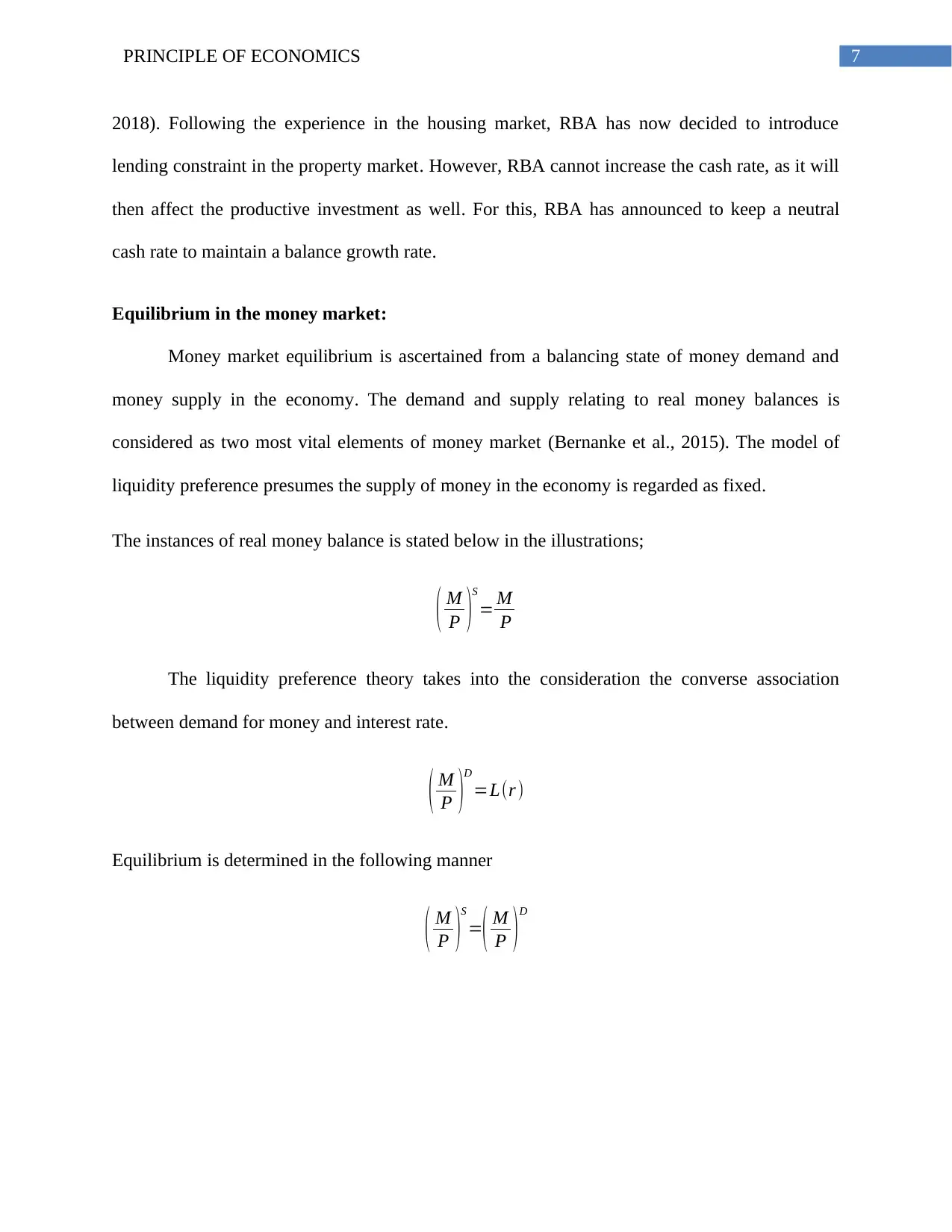
7PRINCIPLE OF ECONOMICS
2018). Following the experience in the housing market, RBA has now decided to introduce
lending constraint in the property market. However, RBA cannot increase the cash rate, as it will
then affect the productive investment as well. For this, RBA has announced to keep a neutral
cash rate to maintain a balance growth rate.
Equilibrium in the money market:
Money market equilibrium is ascertained from a balancing state of money demand and
money supply in the economy. The demand and supply relating to real money balances is
considered as two most vital elements of money market (Bernanke et al., 2015). The model of
liquidity preference presumes the supply of money in the economy is regarded as fixed.
The instances of real money balance is stated below in the illustrations;
( M
P )
S
= M
P
The liquidity preference theory takes into the consideration the converse association
between demand for money and interest rate.
( M
P )D
=L(r )
Equilibrium is determined in the following manner
( M
P )
S
=( M
P ) D
2018). Following the experience in the housing market, RBA has now decided to introduce
lending constraint in the property market. However, RBA cannot increase the cash rate, as it will
then affect the productive investment as well. For this, RBA has announced to keep a neutral
cash rate to maintain a balance growth rate.
Equilibrium in the money market:
Money market equilibrium is ascertained from a balancing state of money demand and
money supply in the economy. The demand and supply relating to real money balances is
considered as two most vital elements of money market (Bernanke et al., 2015). The model of
liquidity preference presumes the supply of money in the economy is regarded as fixed.
The instances of real money balance is stated below in the illustrations;
( M
P )
S
= M
P
The liquidity preference theory takes into the consideration the converse association
between demand for money and interest rate.
( M
P )D
=L(r )
Equilibrium is determined in the following manner
( M
P )
S
=( M
P ) D
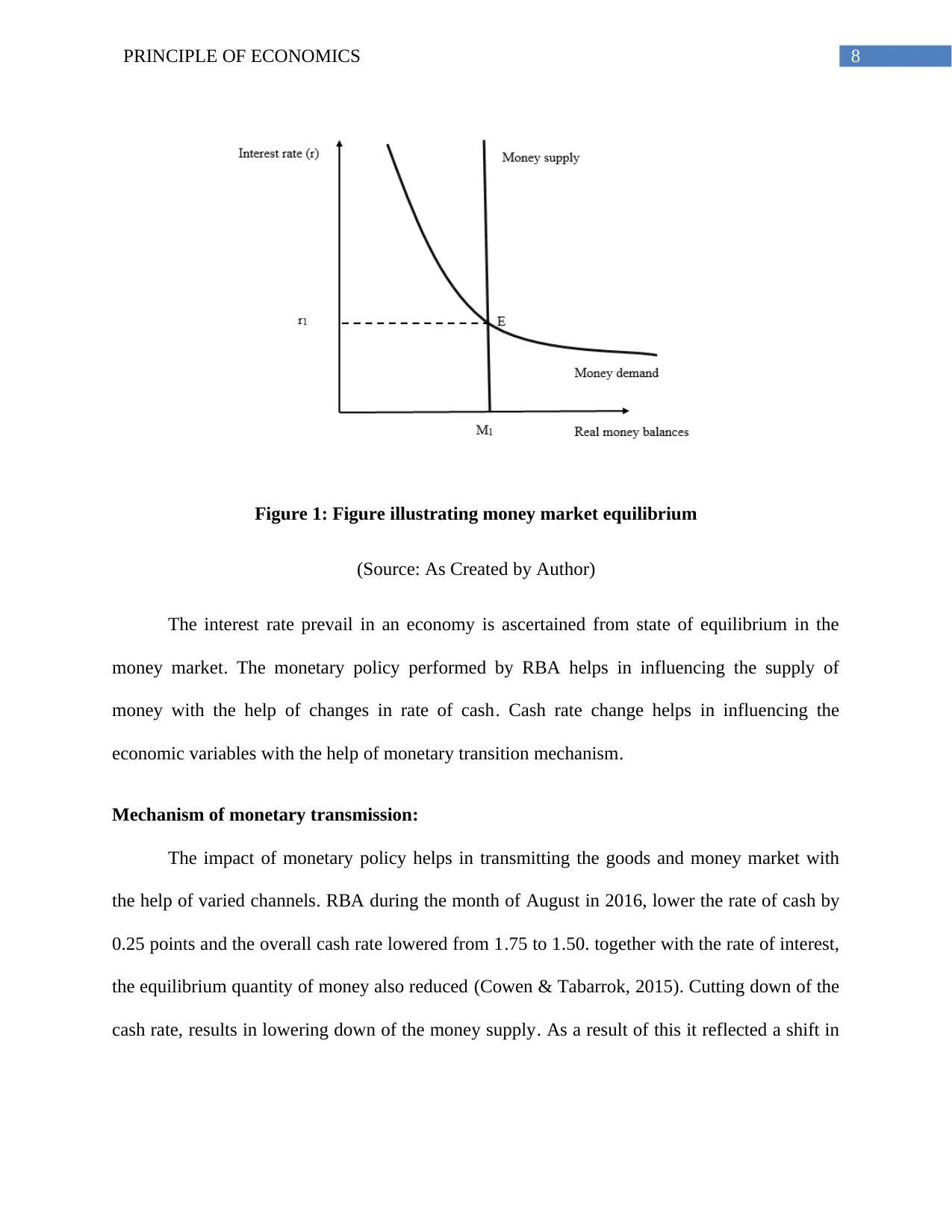
8PRINCIPLE OF ECONOMICS
Figure 1: Figure illustrating money market equilibrium
(Source: As Created by Author)
The interest rate prevail in an economy is ascertained from state of equilibrium in the
money market. The monetary policy performed by RBA helps in influencing the supply of
money with the help of changes in rate of cash. Cash rate change helps in influencing the
economic variables with the help of monetary transition mechanism.
Mechanism of monetary transmission:
The impact of monetary policy helps in transmitting the goods and money market with
the help of varied channels. RBA during the month of August in 2016, lower the rate of cash by
0.25 points and the overall cash rate lowered from 1.75 to 1.50. together with the rate of interest,
the equilibrium quantity of money also reduced (Cowen & Tabarrok, 2015). Cutting down of the
cash rate, results in lowering down of the money supply. As a result of this it reflected a shift in
Figure 1: Figure illustrating money market equilibrium
(Source: As Created by Author)
The interest rate prevail in an economy is ascertained from state of equilibrium in the
money market. The monetary policy performed by RBA helps in influencing the supply of
money with the help of changes in rate of cash. Cash rate change helps in influencing the
economic variables with the help of monetary transition mechanism.
Mechanism of monetary transmission:
The impact of monetary policy helps in transmitting the goods and money market with
the help of varied channels. RBA during the month of August in 2016, lower the rate of cash by
0.25 points and the overall cash rate lowered from 1.75 to 1.50. together with the rate of interest,
the equilibrium quantity of money also reduced (Cowen & Tabarrok, 2015). Cutting down of the
cash rate, results in lowering down of the money supply. As a result of this it reflected a shift in
⊘ This is a preview!⊘
Do you want full access?
Subscribe today to unlock all pages.

Trusted by 1+ million students worldwide

9PRINCIPLE OF ECONOMICS
the supply of money curve. Consequently, a new balancing state is attained on the intersection
point of shifted supply curve and prevalent money demand curve.
Figure 2: Figure illustrating the Monetary transmission mechanism
(Source: As Created by Author)
the supply of money curve. Consequently, a new balancing state is attained on the intersection
point of shifted supply curve and prevalent money demand curve.
Figure 2: Figure illustrating the Monetary transmission mechanism
(Source: As Created by Author)
Paraphrase This Document
Need a fresh take? Get an instant paraphrase of this document with our AI Paraphraser

10PRINCIPLE OF ECONOMICS
Economic performance indicators of Australia:
Cash rate trend in Australia:
Figure 3: Figure illustrating cash rate trend
(Source: rba.gov.au, 2018)
The cash rate is adjusted by RBA to meet the targeted goals. Responding the recession of
1991, RBA undertaken an easy monetary policy which resulted a reduction in the cash rate from
the period of 1990 to 1995. From the year 2008, a stable amount of cash rate of 5% is maintained
by RBA. Furthermore, responding to the Global financial crisis, the cash rate of RBA has
declined further (Goodwin et al., 2015). The cash rate has lowered down further with cash rate
reaching around 2% and in the later stages falling to 1.75% and 1.50%.
GDP growth in Australia:
Economic performance indicators of Australia:
Cash rate trend in Australia:
Figure 3: Figure illustrating cash rate trend
(Source: rba.gov.au, 2018)
The cash rate is adjusted by RBA to meet the targeted goals. Responding the recession of
1991, RBA undertaken an easy monetary policy which resulted a reduction in the cash rate from
the period of 1990 to 1995. From the year 2008, a stable amount of cash rate of 5% is maintained
by RBA. Furthermore, responding to the Global financial crisis, the cash rate of RBA has
declined further (Goodwin et al., 2015). The cash rate has lowered down further with cash rate
reaching around 2% and in the later stages falling to 1.75% and 1.50%.
GDP growth in Australia:

11PRINCIPLE OF ECONOMICS
Gross Domestic Product (GDP) is regarded as the measurement of value of goods and
services that is produced in an economy in terms of monetary terms.
Figure 4: Figure illustrating growth in GDP
(Source: tradingeconomics.com, 2018)
The Australian economy has recorded a growth a rate of 0.6 percent. An assertion can be
bought forward by stating that the growth rate has fall down from the figures reported in the
earlier quarter at the growth rate of 0.9 per cent (Sunley, 2017). The positive growth rate
represents a constant rise in GDP. Hence, a strong monetary policy with lower rate of cash has
assisted the economy in maintaining the rate of growth.
Inflation:
Inflation can be defined as the steady rise in price level in an economy.
Gross Domestic Product (GDP) is regarded as the measurement of value of goods and
services that is produced in an economy in terms of monetary terms.
Figure 4: Figure illustrating growth in GDP
(Source: tradingeconomics.com, 2018)
The Australian economy has recorded a growth a rate of 0.6 percent. An assertion can be
bought forward by stating that the growth rate has fall down from the figures reported in the
earlier quarter at the growth rate of 0.9 per cent (Sunley, 2017). The positive growth rate
represents a constant rise in GDP. Hence, a strong monetary policy with lower rate of cash has
assisted the economy in maintaining the rate of growth.
Inflation:
Inflation can be defined as the steady rise in price level in an economy.
⊘ This is a preview!⊘
Do you want full access?
Subscribe today to unlock all pages.

Trusted by 1+ million students worldwide
1 out of 20
Related Documents
Your All-in-One AI-Powered Toolkit for Academic Success.
+13062052269
info@desklib.com
Available 24*7 on WhatsApp / Email
![[object Object]](/_next/static/media/star-bottom.7253800d.svg)
Unlock your academic potential
Copyright © 2020–2025 A2Z Services. All Rights Reserved. Developed and managed by ZUCOL.





